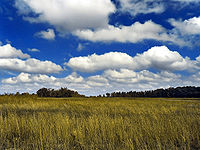
Photo from wikipedia
Abstract Vaporization and two-stage autoignition of single droplets inside the droplet clouds were numerically studied using a spherical cell model. We aimed to investigate the behaviors of individual droplets in… Click to show full abstract
Abstract Vaporization and two-stage autoignition of single droplets inside the droplet clouds were numerically studied using a spherical cell model. We aimed to investigate the behaviors of individual droplets in a moderately hot ambient (600–800 K) under the influence of surrounding droplets at atmospheric pressure. For a given ratio of distance between droplets L and the droplet diameter D0, autoignition only occurs when D0 is above certain critical value. Exemplar cases with L/D0 = 10 were used for detailed discussion as they are found to be near the autoignition limit. For droplets smaller than 400 μm, no ignition occurs and the surrounding gas phase is saturated by fuel vapor before the droplet completely vaporizes. A simple model of final saturation state was established. With this model, it was observed that when the gas phase in the droplet cloud is saturated, the temperature and fuel concentration distributions are insensitive to the distance between droplets. For droplets larger than 500 μm, a variety of autoignition processes including first stage ignition, cool flame burning, second stage ignition, and diffusional extinction are observed. Unlike single isolated droplets, such behaviors are primarily due to heat accumulation and limited supply of oxidizer that pertains to the scenario of non-dilute droplet cloud. Autoignition of individual droplets in a cloud only happens in the region where chemical time scale is smaller than the physical time scale for vaporization and diffusion. The temperature range of autoignition is broadened with increasing initial droplet diameter. Two potential mechanisms were identified for such broadening. Analyses of ‘probable droplet cloud autoignition (PDCA)’ region were found to qualitatively predict the state switch of vaporization, cool flame ignition, and second stage ignition.
Journal Title: International Journal of Heat and Mass Transfer
Year Published: 2021
Link to full text (if available)
Share on Social Media: Sign Up to like & get
recommendations!